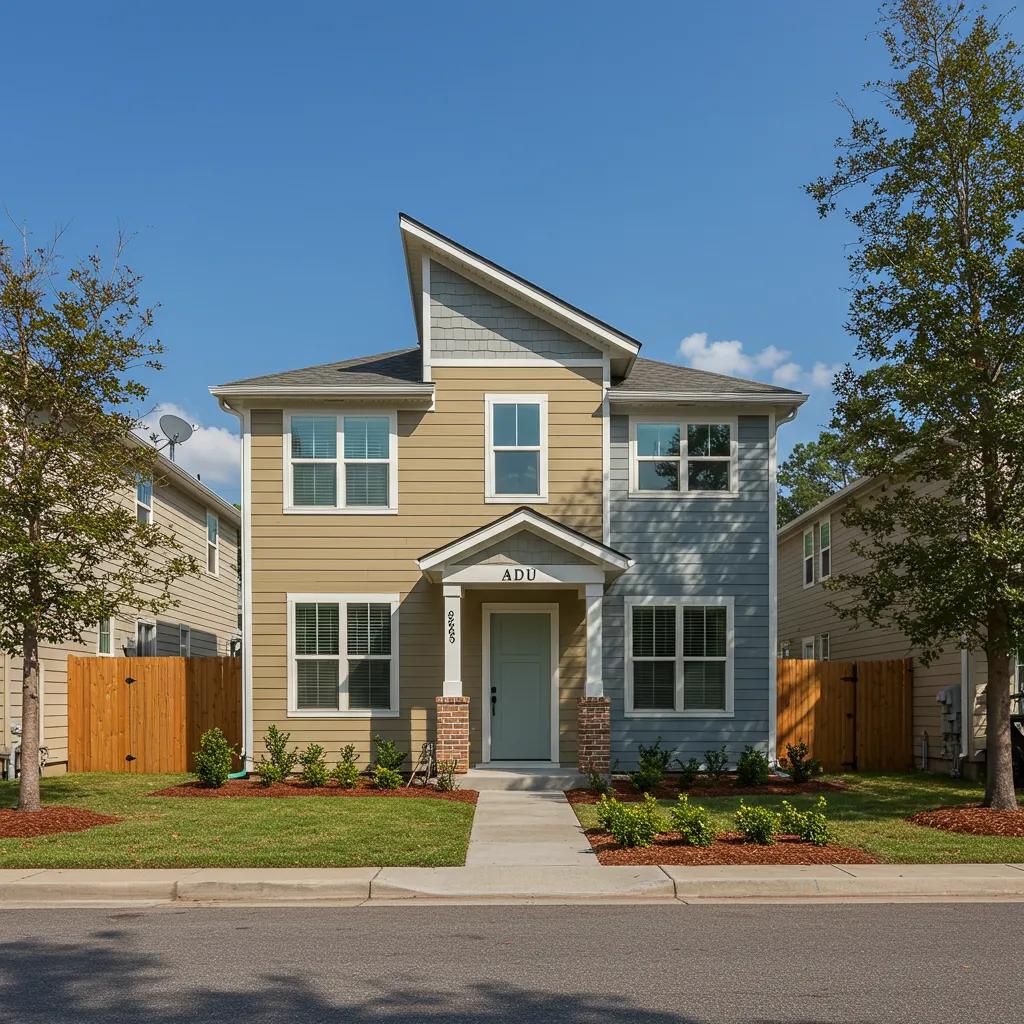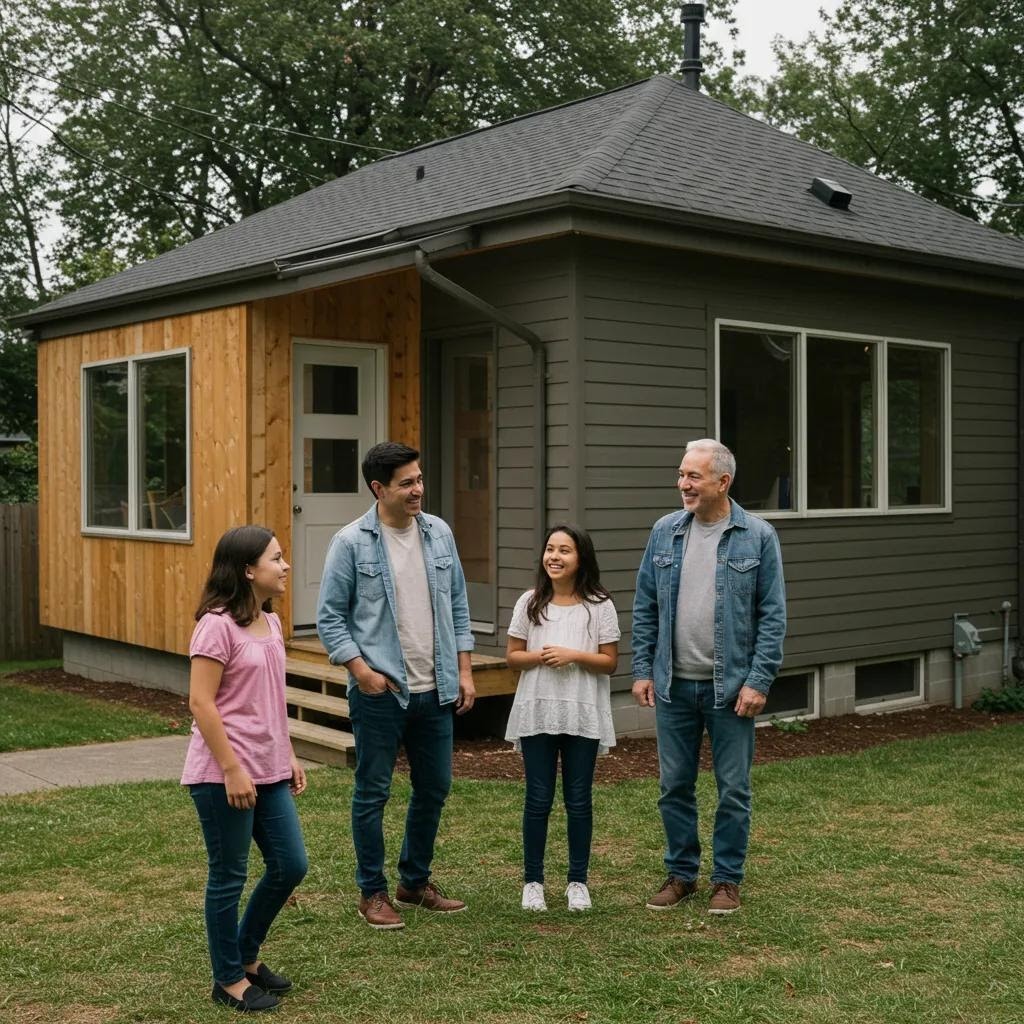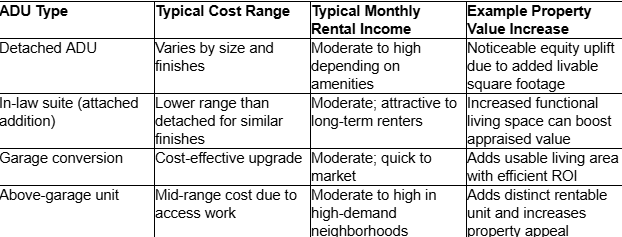Orlando ADU Builder Reviews: Real Client Testimonials You Can Trust About Our ADU Building Services

Homeowners in Orlando trust independent client reviews to decide whether an accessory dwelling unit (ADU) project will deliver value, timely completion, and clear communication. This article synthesizes real ADU construction stories and Orlando ADU homeowner reviews to show what previous clients say about their experiences with ADU building services, focusing on permits, design, timelines, and economic outcomes. Readers will learn common themes in client feedback, how ADUs meet family needs—like in-law suites and garage conversions—what measurable rental income and equity outcomes homeowners report, and how the construction and permit process typically unfolds. The guide emphasizes practical takeaways for prospective ADU owners: what to ask, which features produce the best homeowner satisfaction, and how to interpret testimonial-based claims about ROI and local code navigation. Throughout, we weave in verified information about TEK Construction Group’s ADU offerings as context for common homeowner questions without replacing broader topic guidance. Next we examine overall homeowner themes, then family-focused ADUs, financial outcomes, permitting experience, design collaboration, neighborhood feedback, and finally how to request a free estimate.
What Do Orlando Homeowners Say About Their ADU Building Experience?
Orlando homeowners report that their ADU building experiences are defined by four core factors: permit handling, communication, build quality, and timeline management, which together produce predictable value and reduced homeowner stress. This combination works because local code knowledge and clear scope-setting prevent common delays and keep costs transparent, producing faster approvals and higher satisfaction. Understanding these themes helps homeowners evaluate Orlando ADU contractor options and interpret reviews as evidence rather than marketing. The next subsections break down examples of local expertise, recurring praise points, and how testimonials reflect commitments to transparency, each illustrated with aggregated homeowner feedback rather than single sourced quotes.
How Have Clients Benefited From TEK Construction Group’s Local Expertise?
Clients consistently note that local expertise—in particular familiarity with Orlando and Central Florida codes, setbacks, and inspection expectations—reduces approval time and rework on ADU projects. That local knowledge functions as a mechanism: contractors who understand municipal nuances prepare permit-ready documents and avoid common code pitfalls that cause repeated inspections. Homeowners say the benefit is less direct oversight required from them and fewer schedule interruptions, which increases confidence through completion. These experiences highlight why deciding factors include a builder’s regional track record and demonstrated permit success, which we explore further in the construction process section.
What Are Common Themes in Orlando ADU Client Testimonials?

Homeowner testimonials commonly emphasize four repeating themes that matter to new ADU owners: clear communication, workmanship quality, timely completion, and predictable costs. These themes arise because transparent project management and durable materials both reduce long-term maintenance and preserve resale appeal. Homeowners note that when a team maintains regular updates, clarifies scope changes immediately, and commits to workmanship standards, perceived value increases. Recognizing these recurring themes helps prospective clients prioritize questions during initial estimates and site visits to vet potential builders.
How Do Testimonials Reflect Our Commitment to Quality and Transparency?
Testimonials—when aggregated—often highlight fixed-price expectations, material quality, and straightforward billing as markers of transparency that reduce homeowner anxiety about surprise costs. This pattern occurs because fixed-price contracts and clear scopes align incentives and minimize contentious change orders during construction. Homeowners who describe feeling well-informed throughout the build also report higher satisfaction with finished ADUs and fewer post-completion disputes. These testimonial trends lead naturally into family-focused ADU use cases, where functionality and long-term durability matter most.
How Do ADU Projects Meet Family Needs in Central Florida?
ADU projects meet family needs by creating private, adaptable living spaces that support multigenerational households, caregiving for aging parents, and housing for adult children, while preserving the main house’s privacy and functionality. Mechanically, ADUs accomplish these goals through separate entries, efficient kitchen-bath footprints, and accessible design choices that support both independence and safety. Understanding typical family use cases clarifies which ADU types—detached ADUs, in-law suites, garage conversions, or above-garage units—fit particular household priorities. The following subsections examine in-law suite outcomes, adult-child living solutions, and the specific features homeowners appreciate most in family-oriented ADUs.
What Do Clients Say About In-Law Suite and Aging Parent ADUs?
Homeowners indicate that in-law suites and ADUs for aging parents provide peace of mind by combining proximity with independence, and they often prioritize accessibility adaptations such as walk-in showers and zero-step entrances. The mechanism is straightforward: targeted accessibility features reduce daily care friction and allow older adults to retain autonomy while remaining close to family support. Reported outcomes include improved caregiver logistics and a reduced need for external assisted-living moves, which many families value highly. These family-focused benefits naturally prompt interest in design customization and durable finishes that support long-term livability.
How Have Adult Children Benefited From Custom ADU Designs?
Adult children and returning students find ADUs deliver affordable, private housing that supports transitional life stages without requiring full relocation, with designs often emphasizing a compact kitchen, study space, and separate access. This benefit arises because small-footprint ADUs provide complete living units that can be rented or used by family members, preserving the main house while unlocking rental income potential. Homeowners who host adult children report that customized layouts balance privacy and oversight and often reduce housing costs for younger adults. These use cases tie directly to economic outcomes discussed in the next section.
Which Features Do Homeowners Appreciate Most in Family-Focused ADUs?
Families commonly request a set of practical features that maximize safety, comfort, and rental appeal within limited square footage. The most appreciated features address accessibility, functionality, and privacy and are implemented to serve both family living and potential rental use.
- Accessibility adaptations like step-free entrances and wider doorways improve daily usability and long-term independence.
- Full kitchen functionality with efficient layouts supports independent living and rental desirability.
- Separate entrances and designated parking maintain privacy between the ADU and main house.
These feature priorities help homeowners choose build options that satisfy both immediate family needs and longer-term investment goals.
How Have ADUs Increased Property Value and Rental Income for Our Clients?
ADUs increase property value and rental income by adding a legally rentable living unit and increasing usable square footage, which can raise appraised value and create a steady income stream for homeowners. The mechanism linking ADUs to equity is the addition of functional living space and independent utilities or access that appraisers and renters both value. Homeowners track outcomes in rental ranges and perceived home equity gains, and aggregated reports point to measurable rental income and improved resale appeal. Below we present rental-income success patterns, equity impacts, and statistics that contextualize client claims about ADU returns.
What Rental Income Success Stories Do Orlando Homeowners Share?
Orlando homeowners typically report rental income outcomes for ADUs that vary by unit type, size, and neighborhood demand; many owners view ADU rent as a consistent supplemental income source that offsets financing or maintenance. Mechanically, an ADU becomes an income-producing asset by offering independent living amenities and marketable features like full kitchens and private parking. Homeowners report strong interest in neighborhoods with high rental demand, which supports occupancy and revenue stability. These rental outcomes often factor into decisions about ADU size, finishes, and whether to pursue detached ADUs versus attached in-law suites.
Introductory note: The table below compares ADU types with typical cost and rental outcomes based on aggregated homeowner experiences and market patterns, helping readers estimate economic potential for different ADU strategies.

How Do Clients Describe the Impact of ADUs on Home Equity?
Clients commonly describe ADUs as contributors to home equity by transforming underused parcels—such as backyards or garages—into functional, marketable living space that appraisers recognize. The mechanism is additive: the market values usable living area and legal rental potential, which raises comparable sales metrics. Homeowners often cite improved resale interest and willingness among buyers to pay premiums for a permitted secondary dwelling. Understanding which features (quality materials, separate utilities, and independent entries) most influence appraisals helps owners prioritize upgrades that maximize equity gains.
Research into ADU policy impacts in cities like Los Angeles demonstrates how ordinances can diversify ADU development and influence property characteristics, highlighting the importance of local regulations.
ADU Policy Impact on Development in Los Angeles
Since the accessory dwelling unit (ADU) has emerged as a policy alternative to increase housing stock and provide affordable options for areas impacted by housing shortages, many local governments recently adopted ADU policies that promote the construction of ADUs. Taking the City of Los Angeles as the study area, this paper examines how the city’s ADU ordinance impacts the relationship of the characteristics of the properties and neighborhoods with ADU development by constructing multilevel logistic regression models. The outputs of the models suggest that the ordinance contributes to diversifying the types and locations of the properties and neighborhoods where ADUs are built. The influence of the property characteristics associated with ADU development before the implementation of the ordinance significantly diminished after the ordinance. The outputs also indicate that the ordinance probably attracted ADU developments in the areas with higher accessibility to bus transit. These findings will help planners take appropriate actions and policies that support ADU developments.
The influence of accessory dwelling unit (ADU) policy on the contributing factors to ADU development: an assessment of the city of Los Angeles, D Kim, 2023
What Statistics Support Client Claims About ADU Investment Returns?
Industry patterns and aggregated homeowner outcomes suggest ADUs can deliver measurable returns through rental income and increased property value, though exact percentages vary by market conditions and ADU type. Recent market analyses indicate that properly permitted ADUs frequently outperform simple renovations because they add a separate income stream and distinct living area valued in comparable sales. Homeowners’ reported outcomes align with these trends when ADUs are built to local code and use durable materials that match neighborhood expectations. Recognizing these statistics helps prospective builders set realistic ROI expectations before committing to a design.
How Do Clients Describe Their Experience With Permits and Construction Process?
Yes — when permits and inspections are handled by local experts, homeowners report smoother ADU build processes with fewer surprises and clearer timelines. The mechanism is straightforward: a contractor familiar with municipal requirements prepares complete permit packages and coordinates inspections, which reduces rejection cycles and schedule slippage. Clients value clarity around each phase—design, permitting, construction, and inspection—because it limits homeowner involvement to decisions rather than administrative burden. The following subsections detail how builders’ roles reduce homeowner effort, typical timeline performance, and communication strengths that homeowners commonly note.
What Do Homeowners Say About TEK Construction Group’s Permit Handling?
Homeowners say that permit handling by a knowledgeable contractor reduces backlog and mitigates the risk of repeated corrections, because experienced builders compile plans and documentation that meet local codes. TEK Construction Group’s verified service information indicates they handle all permits and inspections, which minimizes homeowner administrative tasks and helps keep projects on schedule. The benefit to homeowners is practical: fewer permit-related delays and a clearer path from approval to construction. Understanding what a builder does during permit phase informs homeowner expectations and clarifies why permit-capable contractors are often preferred.
Introductory note: The table below breaks down phases of permit and inspection work, the builder role, and the homeowner benefits to show how contractor-led permitting reduces friction.

How Do Clients Rate the Smoothness of the ADU Construction Timeline?
Homeowners typically report that construction timelines vary by ADU type and site conditions but that reliable project management and permit handling produce predictable schedule windows. When a contractor sequences trades properly and anticipates inspection lead times, the result is fewer stoppages and clearer completion projections. Homeowners praise teams that provide updated schedules and proactively communicate adjustments, which reduces perceived delays and maintains trust. These timeline expectations set the stage for the next topic: ongoing communication and project management.
What Feedback Do Clients Give About Communication and Project Management?
Clients emphasize responsiveness, a single point of contact, and transparent milestone updates as key communication strengths that improve satisfaction during ADU projects. The mechanism is that centralized project management reduces miscommunication between subcontractors and homeowners and allows issues to be resolved quickly. Homeowners appreciate teams that confirm decisions in writing and provide sequence-based timelines that map to permit and inspection milestones. Effective communication thus becomes a core differentiator in testimonial-driven trust signals.
After these process-focused sections, it is useful to note specific project credentials: TEK Construction Group is licensed and insured, offers fixed-price contracts that limit surprise costs, and reports a proven track record with over 50 successful ADU projects in Central Florida. Mentioning these verified business attributes clarifies why some homeowners choose a contractor that handles permits, inspections, and fixed-price agreements when they prioritize predictability and local expertise.
What Do Clients Say About Custom ADU Design and Personalization?
Custom ADU design and personalization are praised for aligning unit aesthetics and function with the main house, using tailored material selections and layout optimizations that preserve neighborhood style and homeowner preferences. The mechanism behind successful customization lies in collaborative design: listening to client requests, translating needs into efficient floor plans, and applying material choices that withstand Florida weather while matching existing homes. Homeowner satisfaction centers on both aesthetic cohesion and functional performance, which supports higher rental appeal and long-term durability. The next subsections examine how homeowners experience tailored designs, common request fulfillment, and the collaboration quality with design teams.
How Have Homeowners Experienced Tailored ADU Designs That Match Their Homes?
Homeowners report that ADUs with matched exterior materials, rooflines, and proportionate window patterns create seamless additions that feel native to the property rather than afterthoughts. This outcome occurs because designers prioritize material selection and scale to echo the main residence, improving curb appeal and neighborhood fit. Homeowners appreciate when interior finishes—flooring, cabinetry, and trim—also complement existing interiors, which helps both family use and resale perception. These design outcomes encourage prospective owners to prioritize design alignment in their initial planning conversations.
Introductory note: The table below lists common client requests, the design response, and resulting client outcomes to illustrate how customization delivers practical benefits.

What Are Common Client Requests and How Were They Fulfilled?
Clients frequently ask for open-plan living, accessibility options, energy-efficient fixtures, and storage-maximizing solutions—requests that builders fulfill through layout adjustments, ADA-conscious details, and durable material selections. The technical response typically includes careful space planning to preserve circulation, specification of resilient finishes suited to Florida climate, and integration of efficient HVAC and lighting systems. Homeowners appreciate tangible solutions such as deep storage, built-in shelving, and flexible furniture zones that extend the usability of smaller ADUs. These feature-level choices support both daily use and longer-term appeal when owners contemplate rental or resale.
How Do Clients Describe the Collaboration With Our Design Team?

Homeowners describe effective collaboration as iterative, with designers presenting options, integrating feedback, and refining drawings until the design aligns with lifestyle and budget goals, which creates ownership over final outcomes. This collaborative mechanism increases alignment and reduces late-stage changes, which preserves the fixed-price contract integrity and timeline. Clients value clear visualizations and timely responses to modification requests, which fosters trust and smoother construction handoffs. The described collaborative process naturally leads into neighborhood-level testimonials and local relevance.
Within design discussions, TEK Construction Group’s service offering—Accessory Dwelling Units (ADUs), including detached ADUs, in-law suites (attached additions), garage conversions, and above-garage units—aligns with common homeowner requests for tailored solutions, and the company’s approach to design collaboration supports those outcomes without adding administrative burden.
Where Are Our ADU Projects Located and What Do Neighborhood Clients Say?
Neighborhood-level reviews help prospective homeowners understand how ADU outcomes vary by community characteristics and market demand in Orlando and Central Florida. Testimonials from Winter Park, Kissimmee, Lake Nona, and Windermere illustrate differences in rental demand, design expectations, and resale appetite, since local market conditions influence both income potential and material preferences. Presenting neighborhood-specific patterns helps homeowners set expectations about permitted ADU types, optimal finishes, and likely tenant profiles. The following subsections highlight patterns and homeowner feedback by area.
What Testimonials Come From Winter Park and Surrounding Areas?
Homeowners in Winter Park often emphasize high design standards and curb appeal when describing ADU projects, noting that well-matched exterior materials and landscaping increase resale interest and neighborhood acceptance. This trend arises because buyers in the area expect cohesive architecture and quality finishes, which encourages design-sensitive investments. Homeowners who prioritized matching aesthetics reported greater ease in marketing the property for sale or short-term rental conversions.
How Do Clients in Kissimmee and Lake Nona Describe Their ADU Experience?
Kissimmee and Lake Nona homeowners frequently reference rental demand and occupancy as core outcomes of ADU projects, with property location influencing expected rent and tenant turnover. The mechanism is market-driven: areas with growing rental demand support higher occupancy and steady income, which many homeowners prioritize when planning detached ADUs or garage conversions. Homeowners note that functional layouts and independent amenities attract long-term renters, validating the ADU investment in these neighborhoods.
What Do Windermere Homeowners Say About Their ADU Projects?
Windermere homeowners tend to emphasize high-quality finishes, refined design integration, and material durability when discussing ADU outcomes, reflecting local expectations for premium aesthetics. This emphasis translates into choices for resilient exterior materials and interior finishes that match the main residence’s standards. Homeowners report that attention to proportional design and finish quality improves long-term resale appeal. Understanding neighborhood-specific priorities such as these helps homeowners align budgets with expected local returns.
How Can Prospective Clients Share Their ADU Vision and Join Our Satisfied Homeowners?
Prospective clients can move from concept to estimate through a clear, three-step process that focuses on vision capture, site assessment, and a transparent estimate, enabling informed decisions about ADU type, budget, and timeline. The mechanism is structured contact and assessment: initial conversations clarify goals, site visits verify feasibility, and fixed-price estimates outline scope and costs. This process reduces uncertainty and supports confident project starts. The subsequent subsections list the step-by-step process, explain transparent pricing advantages, and direct readers to where detailed client stories and videos can be found.
What Are the Steps to Get a Free ADU Estimate From TEK Construction Group?
- Contact and initial consultation: Share your ADU vision and basic property details to begin scoping (expected 1–3 days for scheduling).
- Site visit and feasibility: A site visit verifies setbacks, utilities, and potential ADU placement while defining scope (expected 1–2 weeks for evaluation).
- Fixed-price estimate and next steps: Receive a detailed, fixed-price proposal that outlines scope, timeline, and permit plan (expected 1–2 weeks for delivery).
How Do New Clients Benefit From Our Transparent Pricing and Fixed-Price Contracts?
Transparent pricing and fixed-price contracts protect homeowners from surprise change order markups by defining scope and costs up front, which aligns builder and homeowner expectations and reduces adversarial billing disputes. This contractual mechanism gives owners predictable budget planning and clearer mortgage or financing conversations. Homeowners express greater confidence when the fixed-price approach covers labor, materials, and a specified scope of permits and inspections. These protections are particularly valuable in markets where permitting and inspection schedules affect overall project costs and timelines.
Where Can Homeowners Read More Detailed Client Stories and Watch Video Testimonials?
Homeowners seeking deeper testimonial evidence and richer project context can review case studies, project galleries, and video testimonial collections prepared by reputable builders and industry resources to validate claims about permit success, rental income, and design outcomes. Watching short case-study videos and reading neighborhood-specific stories helps align expectations and identifies best practices for unit types and finishes. Prospective clients are encouraged to request references and inquire about neighborhood examples to match their ADU goals to local market realities.
This article has explained what Orlando homeowners report about their ADU building experiences, covered family-use cases and financial outcomes, detailed permit and construction expectations, described design collaboration, summarized neighborhood patterns, and provided a clear three-step path to request a free estimate while outlining how transparent, fixed-price contracts protect homeowner budgets.

